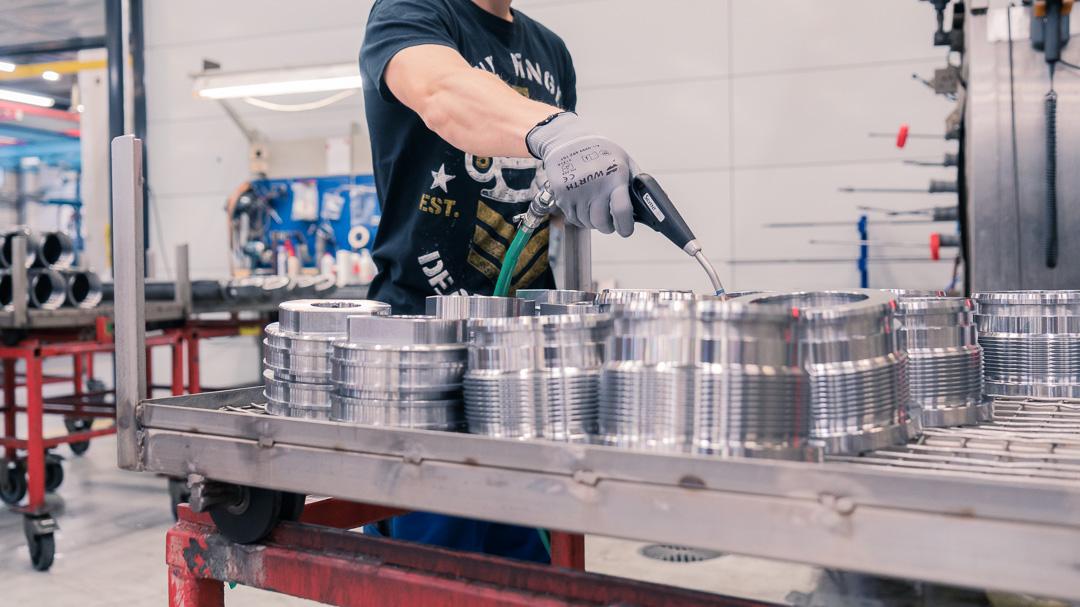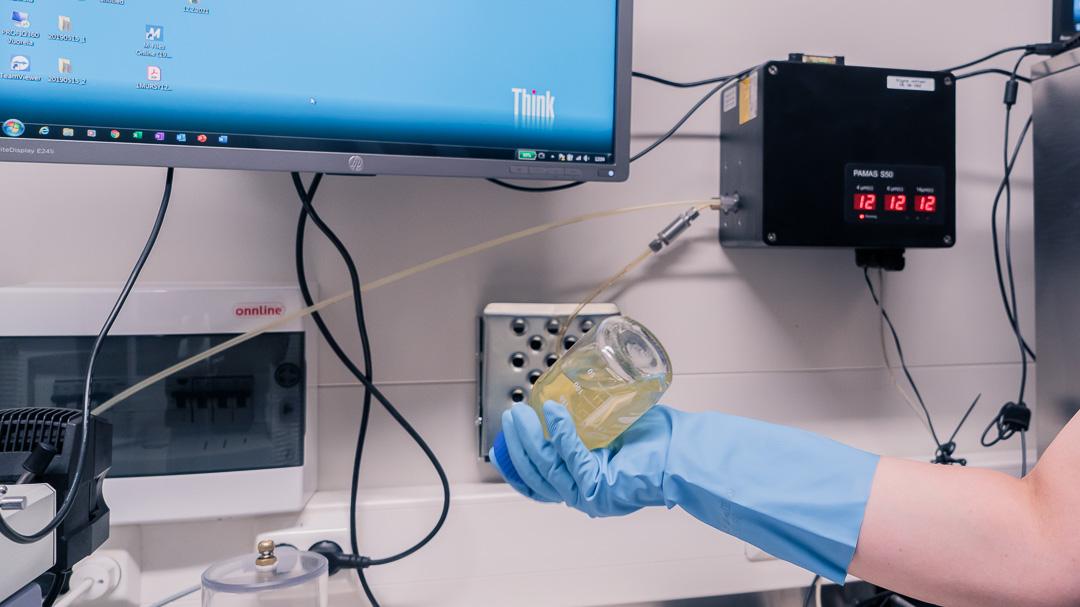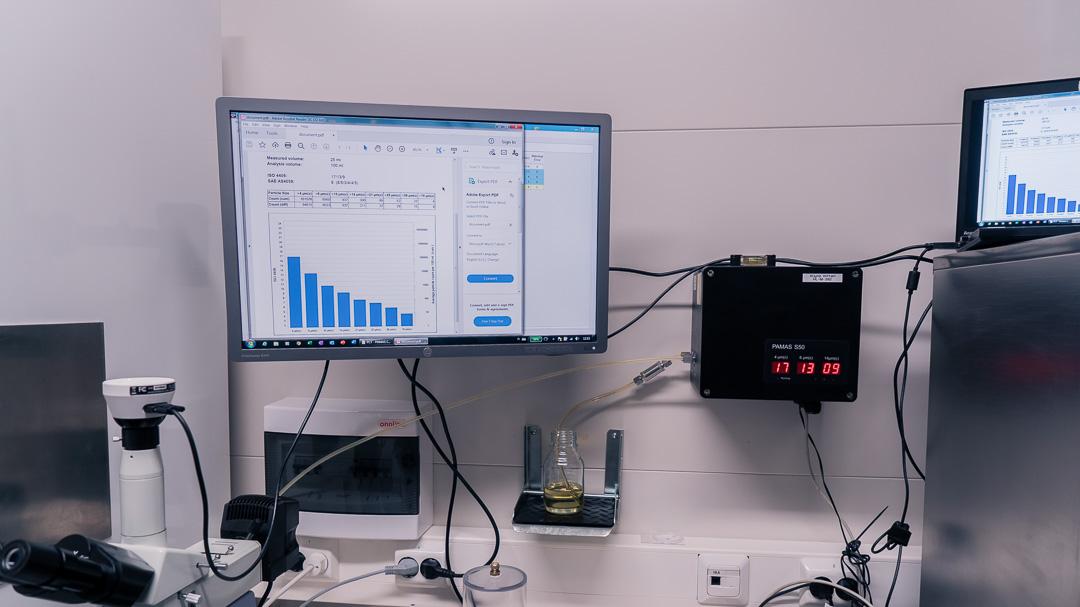Cleanliness in hydraulics
Nowadays, merely maintaining fluid cleanliness in hydraulic systems can reduce operational costs by as much as two-thirds. The system cleanliness means improved uptime, higher performance levels, and a reduction in operation price.
The operators rely on modern equipment to get the job done. What does modern equipment rely on, then? The answer is evident – A highly efficient, reliable, and robust hydraulic system. As an energy source, fluid power can produce higher forces in small volumes than electrically driven systems. Maintaining an appropriate level of cleanliness is vital to hydraulic systems’ success in any hydraulic equipment operation. The contamination in hydraulic fluid is the most critical factor influencing the system’s reliability – between 50 and 70% of all hydraulic system failures can be linked to contamination.
Taking proactive and predictive steps to ensure oil cleanliness can go a long way to moderate this risk. By implementing processes to provide fluid and system cleanliness, maintenance professionals can increase system components’ lives and reduce unplanned downtime and maintenance costs.
To simplify it – the cleaner the oil, the longer the equipment will operate reliably. The operators that keep their hydraulic processes clean have an immediate advantage compared to those that don’t. Ensuring proper hydraulic cleanliness enables you to realize the full lifecycle, which means you get the best value out of your investment. Let’s have a closer look at what cleanliness in hydraulic systems means.
In this blog post you can find the following topics
- Objectives in hydraulic cleanliness
- Targets for the hydraulic system cleanliness
- How clean should the hydraulic system be?
- A hydraulic cleanliness program
- Setting targets to ISO codes for fluid power components
- Most common contamination sources in hydraulic systems
- Different types of contaminants
- Proactive Maintenance in Three Easy Steps
- Fluid power as a life-blood of hydraulics
- Hydroline hydraulic repair service
Objectives in hydraulic cleanliness
An overall approach to system cleanliness prevents downtime and related costs in hydraulic system cleanliness. When a hydraulic system faces unexpected downtime due to essential components malfunction from contaminated fluid, profits decrease while production costs increase. Additional unwanted financial charges can feel exponential as components must be repaired or replaced.
When counting all the factors such as maintenance hours, replacement parts, fluid consumed, and decrease in profitability, it’s easy to understand the substantial cost impact of fluid that isn’t following the ISO standards. Fluid contamination issues provide an excellent opportunity to increase, save maintenance costs, and lower operational costs.
The main objective in hydraulic cleanliness is to apply a comprehensive systems cleanliness process. With the cleanliness process, the hydraulic system’s life span will increase by extending the components and the fluid service life. Other benefits include a reduction in maintenance costs and fluids disposal and maximize uptime. For example, upgrading from cellulose to fiberglass filter elements, installing desiccant breathers, and installing off-line filtration can be quite useful in improving hydraulic fluid cleanliness.
 |  |
Targets for the hydraulic system cleanliness
Implementing the total system cleanliness approach to hydraulic systems is vital. Ultimately you can create reliable operations and save money by controlling the contamination and taking care of fluids. Stay focused and avoid the fluid contamination in the hydraulic systems and additional charges associated with fluid contamination. Many steps in the process can cause additional charges as follows: the analysis meetings, maintenance costs, downtime and lost production, components repair and replacement costs, unreliable system performance, and last but not least, wasted time and energy.
We listed a few steps to tackle when creating a cleanliness system:
- Establish a premise and target for the cleanliness process and each system.
- Evaluate all the hydraulic and lubrication systems.
- Establish a fluid analysis program and set up specific fluid cleanliness levels for all the fluids.
- Filter all new fluids when received and also during the transfer.
- Seal all reservoirs and tanks to ensure cleanliness.
- Enhance the filtration systems by installing high-quality desiccant breathers, enhance air, and liquid filtration on existing systems.
- Improve the storage and transfer of bulk fluids.
- Ensure to keep out water and moisture from hydraulic systems.
- Use approved techniques to remove unwanted moisture or water.
- Commit and engage the whole team to fluid cleanliness.
How clean should the hydraulic system be?
How clean should the hydraulic system be then? Consider the following questions such as – What are the objectives? What was the system failure history before? What are the consequences of downtime? What are the standards you are aiming for with cleanliness?
The cleanliness levels of the systems and components are defined based on customer-specific requirements.
- Perform process chain analysis of the entire supply chain – from raw material to the finished product delivered to the customer.
- Consider suppliers’ parts, in-house fabrication, installation, installation tools, washing process, storage, functional testing, logistics, filler (oil), environment.
- Set the purity levels of production according to the most demanding customer.
- Aim for the system oil cleanliness level minimum: 18/16/13 (ISO 4406).
- Notice that typical oil purity purchased directly from the supplier is 20/18/15 (ISO 4406).
- Determine the maximum particle size for impurities and the maximum amount of impurities in mg / m2 (to 2 potencies, per square meter).
A strategic maintenance decision is necessary. In theory, you attempt to minimize the net effect between the investment and the correlated savings from improved reliability.
The cost of the oil’s cleanliness should be more or less the investment cost, increasing the overall net effect. Considering the known factors, you can determine a required cleanliness level with some confidence in the benefits.
A hydraulic cleanliness program
The hydraulic cleanliness process needs to be determined by the customer requirements. The whole process chain needs analysis from the base material to the ready product. There are many different parts of the process that need careful attention, such as producers, assembly, assembly tools, the washing process, storage, testing, logistics, fluids, and environment.
At Hydroline, we have set our cleanliness standards according to our most demanding customer needs.
Target for cleanliness | Set a target for fluid cleanliness for each system by periodic oil analysis with the results reported per ISO 4406. Determine the target cleanliness codes according to the most sensitive component within the system. At Hydroline, we monitor the hydraulic cleanliness with PAMAS S50 online system cleanliness device. Besides, we use workstation-specific and product-specific measurements to monitor the cleanliness performance.
|
Installation of breathers | Install desiccant breathers on all fluid reservoirs. Unprotected or under-protected reservoir vent ports can be one of the most significant sources of contamination entry. Although it can also come from unfiltered new fluid, filtering all-new fluid will also help hold contaminant ingression in check.
|
Identifying insufficient filtration | Identify systems with insufficient filtration and add off-line filtration to filter the fluid during operation continually. Install high-efficiency fiberglass filters in all hydraulic systems to maximize fluid contamination removal.
|
Monitoring component cleanliness | At Hydroline, we monitor the component cleanliness according to ISO 16232 gravimetric measurements.
|
Monitoring equipment and working conditions | We closely monitor washing processes, temperatures, concentration, pH, conductivity. Maintaining and developing the cleanliness of production processes and tools is one of our main focuses on overall cleanliness performance. Also, our producers are part of the process as they have received cleanliness requirements from us.
|
Create maintenance procedures | Develop maintenance procedures to monitor fluid cleanliness and filter element pressure. To ensure consistent results of the fluid analysis, fluid sampling techniques and testing methods should be standardized. The maintenance schedule should be predictive or when they reach a threshold.
|
At Hydroline, we monitor the hydraulic cleanliness with PAMAS S50 online system cleanliness devices.
Setting targets to ISO codes for fluid power components
Once a target ISO cleanliness code is set, follow a progression of steps to achieve that target, monitor it, and maintain it to profit the rewards for your efforts. When setting targets to ISO cleanliness codes for hydraulic systems, keep in mind that the following objectives:
- Maximize equipment reliability and safety
- Minimize repair and replacement costs
- Gain more extended maintenance periods and better usability
- Extend fluid lifespan
- Accommodate warranty requirements
- Reduce or eliminate production downtime.
- Achieve better customer satisfaction.
This process’s first step is to identify the most sensitive components on an individual system or central reservoir components. If a central reservoir provides several methods, the overall cleanliness must be maintained. The high-efficiency filters protect the most sensitive component purifying the fluids before accessing into the system.
The target ISO code should be one value lower if any combination of the following conditions exists in the system:
- Components critical to safety and reliability
- Frequent extreme weather conditions
- When excessive shock or vibration occurs
- Other severe operating conditions
The ISO cleanliness code per ISO 4406 quantifies particulate contamination levels per milliliter. The ISO code is expressed in three numbers, for example, 18/16/13. Each ISO number represents a contaminant level for the correlating particle size. The code includes all particles of the specified size or bigger. Each time a code increases, the number of particles are doubling. On the contrary, when the code decreases by one, the contaminant level is cut in half.
 |  |
Most common contamination sources in hydraulic systems
In an ideal situation, the hydraulic fluid should create a lubricating film to keep precision parts separated. This film should be thick enough to fill the gap between moving parts. The actual thickness depends on fluid viscosity, applied load, and two surfaces’ relative speed faces.
When the contamination particle is larger than the gap between the surfaces, it creates disruption. The friction increases and the damage is evident. This damage introduces more contaminant particles. It’s vital to keep the contaminant particles smaller than the clearance and reduce the size as much as possible.
Hydraulic fluid contamination is a severe issue and can cause considerable damage to hydraulic systems. To effectively deal with contamination, it is crucial to know the potential sources.
1. Hydraulic fluid contamination during production
In most cases, the new hydraulic fluid has, on average, an ISO 4406 Cleanliness Code of 17/16/14 to 20/18/16. This code can be on top of what most manufacturers recommend for their equipment, but experts agree that even this cleanliness level isn’t enough for current hydraulic systems.
How do the hydraulic fluid production processes create contamination? The factories that produce hydraulic fluids may accidentally cause contamination during processing. In most cases, factories rarely control hydraulic fluid storage, which makes another source of contamination. Therefore, emphasizing filtering all fluids that move into a system is vital— even a fresh batch of hydraulic fluid could be already contaminated.
2. Hydraulic fluid contamination during storage
The storage is not necessarily the safest place for hydraulic fluids. Surprisingly, moisture can access the sealed and waterproof plastic containers through a chemical process called breathing. Breathing can occur if a container is exposed to variations in temperatures, such as storing outside where the sun might shine on them. Even though it’s impossible to see moisture contamination, it can still damage the hydraulic system and the operational performance.
If containers aren’t sealed tightly or left open, it can cause another significant opportunity for contamination — such as dust and moisture — to enter. The storage-related contamination can be prevented by storing fluids at a controlled temperature, seal the containers carefully, and lay them on their sides.
3. Contamination during fluid transfer
Fluids exposed to air during transfer and handling run the risk of absorbing moisture and becoming exposed to dust and other air particles. If the working environment and equipment are not clean, contamination will most definitely happen. Besides, ignoring the system flush before adding the new fluid can worsen the contamination. Mixing fluids can create a chemical reaction and cause contamination.
Follow these steps to minimize this type of contamination into a hydraulic system:
- Don’t open the fluid in an area that is not clean.
- Always remember to flush the system before adding new fluid.
- Closed the fluid container lid as soon as possible to avoid contamination.
- Filter the hydraulic fluids always before adding them into the hydraulic system.
4. Contamination during the manufacturing process
It may be surprising, but a hydraulic system may expose contamination during the manufacturing process. There may be tiny Teflon particles from sealing tape on a hydraulic port or grease or other lubricants that weren’t wholly removed while assembling the pump. Perhaps leftover casting sand in the hydraulic motor. All the same, any one of these situations can create contamination in the hydraulic system.
Built-in contamination can be avoided with the appropriate use of filters, including changing the filters regularly and careful handling of the filters when installed.
5. Fluid contamination during service
Contamination can occur during service when the fluid is exposed to higher than average temperatures. Besides, hydraulic fluid naturally degrades over time, so manufacturers recommend that the fluid be changed regularly.
Hydraulic fluid can also get contaminated when exposed to air and moisture. Seals can also be a source of contamination, even when they are not leaking. Tiny seals particles can ride into the cylinder rods’ system and depend on internal filters to capture them.
The components themselves can also generate contamination, such as bearings on a hydraulic motor or the seals on a hydraulic pump, when tiny particles like metal or polymer come off.
In case you suspect the fluid has been contaminated, the system should be flushed, and new filtered hydraulic fluid should be added. The unwanted air and moisture can be reduced using air breathers, vacuum breakers, or vacuum reservoirs. Replace the seals as suggested by the manufacturer or whenever a leak is suspected. It’s also essential to change the filters regularly.
6. Contamination during maintenance
Last but not least, the notorious source of hydraulic fluid contamination is maintenance. During maintenance, there are several ways contamination can happen, that it’s best to talk about how to prevent it.
First, the components’ exterior should be cleaned off, mainly if used in a dirty environment like hydraulic motors used on construction equipment. Only use clean, lint-free clothes. As soon as opened, cap hoses and plug ports immediately. Handle all the hoses and fittings carefully. Seals and filters shouldn’t be removed from their packaging before installation. A proactive approach to prevent contamination during maintenance is vital.
Even a sealed system can have contaminated build-up. Therefore controlling contamination in hydraulic systems with any means is necessary.
Different types of contaminants
In general, hydraulic system contamination can be classified into particle contaminants or chemical contaminants. The damages that contamination may cause are, for example, the formation of rust or other oxidation, accelerated component wear, orifice blockage, depletion of additives, the appearance of different chemicals, and oil degradation.
Chemical contaminants
Water – Moisture is the most common chemical contaminant in hydraulic systems. The presence of moisture may cause wide-ranging effects on system components due to its impact on hydraulic oil’s physical and chemical properties. Oil becomes cloudy when the water contaminates it above its saturation level.
Rust – Corrosion in tanks, reduced lubrication characteristics resulting in accelerated metal surface wear are some of the most apparent physical results of excessive water. However, the effects could be as diverse as the jamming of components due to ice crystals at low temperatures. Chemical effects include additive depletion or deposition, oxidation, and unwanted reactions, resulting in acid formation, alcohols, or sludges.
The air – Air can exist in either a dissolved or entrained state in hydraulic systems. When a hydraulic fluid contains undissolved air, problems can occur as it passes through system components. The control of the system is lost by the compressibility of air. Air bubbles and forming in the oil reservoir can cause significant damage to pumps or cause the oil to boil out of the tank. However, dissolved air may not pose a problem, providing it stays in the solution.
The heat – Excessive heat can cause additive depletion or chemical changes to the fluid in hydraulic systems.
Particle contaminants
Generally, particle sizes are measured in micrometers or microns. Some bigger micron examples are, for example, a grain of salt/100 microns and human hair/70 microns. Some smaller samples of a micron are bacteria, only 2 microns, and not visible to the human eye. Surprisingly the most damage-causing particles in hydraulic or lubrication systems are smaller than 14µm micrometers and not visible to the human eye.
These are the most common particle types found in the fluid of a hydraulic system:
- Metal particles from sawing, machining, welding, grinding.
- Wooden particles from packing materials
- Sand castings and sandblasting
- Resin from cutting fluids and adhesives
- Rubber particles from hoses and rings
- Plastic particles from tools and packaging supplies
- Fibers from fabrics, paper, cardboard
- Paint particles from coatings
- Rust from corrosion of materials and components
Industries now follow the ISO 4406 Cleanliness Standard to overcome these issues.
Proactive Maintenance in Three Easy Steps
Cleaner oil extends your machines’ lives by keeping the frictional zones less exposed to contaminants’ dangerous effects. When you carefully optimize these cleanliness efforts, the investment return can be a significant advantage. The first important step to creating the required cleanliness target (RCL) is developing a proactive maintenance contamination control strategy. The following steps are:
Set the oil cleanliness target. You can set the cleanliness targets through experience and optimized methodologies such as ISO 4406 or NAS 7 and the optimum reference state. The target should ultimately reflect your reliability objectives.
Take actions to achieve these targets. Take measures to reduce ingression and to improve filtration. Reducing ingression is a cost-effective but not a perfect standalone solution. Combining it with improved filtration is necessary for any critical application.
Measure contaminant levels frequently with oil analysis. Take a proactive approach. Knowing the contamination data is a key to a sustainable cleanliness program. Contamination levels are a leading indicator, while wear and failure rates are a lagging indicator. Proactive actions can be reasoned and strengthened with data to validate the cause and effect.
Fluid power as a life-blood of hydraulics
Hydraulic fluid is without a doubt the life-blood of hydraulic systems. Ensuring hydraulic cleanliness and contaminant-free fluids is essential to preventing damage and increasing the hydraulic systems’ life span. Newly developed filter materials for more powerful filter elements reduce operating costs by ensuring a longer service life.
Therefore, for future filter exchanges, users should first compare the technical specifications of filter elements by different suppliers. Independent of the filter housing manufacturer, the operating costs can be significantly reduced using the new generation of filter media.
The 21st Century hydraulics industry is on its way to introduce new hydraulic applications combined with existing technologies to produce more effective solutions in the coming years. Improved technology will help solve the industry’s current challenges by offering inexpensive solutions to the current problems the industry may face. We can also expect that fluid power will be used in many advanced ways, and it will be affordable and easier to maintain. As technology improves, hydraulics systems will also experience enhanced reliability.
The hydraulic industry has come a long way in recent years. Many countries have already recognized fluid power as a primary source of energy. They are embracing hydraulic technology to work more effectively and protect the environment around us. As it becomes more proactive, what does the future hold for this up-and-coming industry?
Hydroline hydraulic repair service
Hydroline’s expert technicians are available to handle your hydraulic systems’ maintenance and service with speed and efficiency. We will provide you with excellent repair and rebuild services, maintain your equipment in top condition with our extensive on-site service options. Our top-knot maintenance service takes care of your: pumps, valves, cylinder rods, hydraulic motors, or complex hydraulic systems. Leave the worry about hydraulic contamination in your key hydraulic systems to us!


